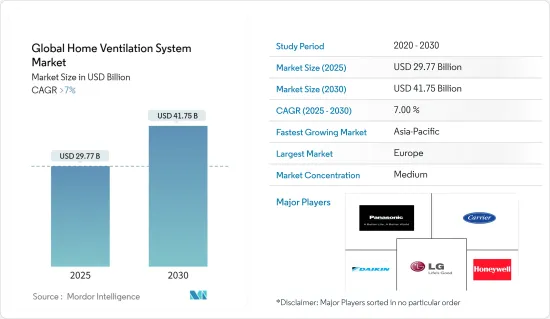 |
市场调查报告书
商品编码
1631633
家庭通风系统:全球市场占有率分析、产业趋势/统计、成长预测(2025-2030)Global Home Ventilation System - Market Share Analysis, Industry Trends & Statistics, Growth Forecasts (2025 - 2030) |
||||||
※ 本网页内容可能与最新版本有所差异。详细情况请与我们联繫。
预计2025年全球家庭通风系统市场规模为297.7亿美元,预计2030年将达到417.5亿美元,在预测期间(2025-2030年)复合年增长率将超过7%。

家庭通风系统为居住者提供安全舒适的居住环境。这些系统可调节家中的气流,以防止烟雾、二氧化碳和挥发性有机化合物等污染物的积聚。如果夏季室外污染物含量较高或室内温度升高,住宅可能需要多个换气扇来排放家中的危险气体。对开放式住宅的需求增加、印度和中国等新兴国家的建设活动活性化以及能源效率意识的提高是推动市场成长的关键因素。此外,人们对室内空气品质日益增长的健康担忧也增加了对住宅高效通风系统的需求。
新冠肺炎 (COVID-19) 疫情过后,人们越来越意识到家庭通风的重要性。随着越来越多的人待在室内,对适当的通风系统以改善室内空气品质的需求不断增长。家庭通风市场的公司致力于开发增强空气流通和过滤的创新解决方案。这包括 HEPA 过滤器、智慧通风系统和节能选项等技术。
家庭通风系统的市场趋势
经济高效的能源回收通风 (ERV) 创新
暖通空调产业的技术开发重点是降低成本和改进现有技术。潜热储存具有较高的储热密度和较小的温度变化,越来越受到人们的欢迎。相变材料(PCM) 在用于蓄热和温度维持应用的HVAC 解决方案中的潜在使用,以及用于优化系统性能并满足商业和工业领域的通风和冷却需求的下一代通风(NeGeV) 创新,是推动因素之一。此外,机械通风系统的重大发展和创新预计将与当前的价格水平相匹配,并显着降低营业成本,同时减少 50-90% 的能源消费量并减少碳足迹。所有上述因素预计将支持市场成长,并为市场参与企业提供利润丰厚的成长机会。
住宅装修产业推动家庭通风系统市场的销售
住宅对节能豪华生活空间的偏好不断变化,对通风系统产业的成长做出了重大贡献。快速的都市化,加上政府为绿色建筑建设提供激励措施和税额扣抵的努力,正在推动住宅通风系统市场的成长。此外,电子商务的普及和技术先进的系统升级的可用性可能会推动全球家庭通风系统的活动。
家庭新风系统产业概况
家庭通风系统市场被许多参与者分割。本报告概述了世界各地经营的家庭通风系统公司。我们想详细介绍一些主要企业的概况,包括其产品、监管法规、总部和财务表现。目前主导市场的一些主要企业包括Panasonic、开利、Honeywell、DAIKIN INDUSTRIES和 LG。
其他好处:
- Excel 格式的市场预测 (ME) 表
- 3 个月的分析师支持
目录
第一章简介
- 研究假设和市场定义
- 调查范围
第二章调查方法
第三章执行摘要
第四章市场动态
- 市场概况
- 市场驱动因素
- 人们对室内空气品质的认识不断增强
- 智慧家庭趋势不断成长
- 市场限制因素
- 部分地区缺乏适当的法规和标准
- 市场机会
- 对节能解决方案的需求不断增长
- 价值链/供应链分析
- 波特五力分析
- 买家/消费者的议价能力
- 供应商的议价能力
- 新进入者的威胁
- 替代品的威胁
- 竞争公司之间的敌对关係
- 对通风系统市场政府法规的见解
- 洞察科技趋势与消费者偏好
- COVID-19 对市场的影响
第五章市场区隔
- 依产品类型
- 排气通风系统
- 供应通风系统
- 平衡通风系统
- 能源回收系统
- 按用途
- 新内饰
- 改革
- 按地区
- 北美洲
- 南美洲
- 欧洲
- 亚太地区
- 中东/非洲
第六章 竞争状况
- 市场竞争概况(市场集中度与併购交易)
- 公司简介
- Panasonic
- Carrier
- Johnson Controls
- Honeywell
- Daikin Industries
- LG
- Samsung
- Lennox
- Unovent
- Atlantic*
第七章 市场未来趋势
第 8 章 免责声明与出版商讯息
The Global Home Ventilation System Market size is estimated at USD 29.77 billion in 2025, and is expected to reach USD 41.75 billion by 2030, at a CAGR of greater than 7% during the forecast period (2025-2030).

Home ventilation systems provide residents with a safe and comfortable living environment. These systems regulate airflow in the home to prevent pollutants like smoke, carbon dioxide, and volatile organic compounds from accumulating. When outdoor pollutant levels are high or indoor temperatures rise during the summer months, homes should have multiple ventilation fans installed throughout the interior to expel dangerous gases from within. The growing demand for open-plan homes, rising construction activity in emerging economies such as India and China, and rising awareness about energy efficiency are some of the key factors driving market growth. Furthermore, growing health concerns about indoor air quality have increased the demand for efficient ventilation systems in residential buildings.
The post-COVID-19 scenario has brought increased awareness about the importance of home ventilation. With more people spending time indoors, there has been a growing demand for proper ventilation systems to improve indoor air quality. Companies in the home ventilation market have been focusing on developing innovative solutions that enhance air circulation and filtration. This includes technologies like HEPA filters, smart ventilation systems, and energy-efficient options.
Home Ventilation System Market Trends
Innovations in Cost-Effective Energy Recovery Ventilation (ERV)
The HVAC industry's technological development is focused on cost-cutting initiatives and improving existing technology. Latent heat storage with higher storage density and smaller temperature changes is becoming more popular. The potential use of Phase Change Material (PCM) in HVAC solutions for thermal storage and temperature maintenance applications, as well as innovations in Next Generation Ventilation (NeGeV) to optimize system performance and meet ventilation and cooling demands for commercial and industrial sectors, are among the factors driving the market growth. Furthermore, significant developments and innovations in mechanical ventilation systems are expected to match current price levels and significantly reduce operating costs while offering 50-90% lower energy consumption and a lower carbon footprint. All of the aforementioned factors are expected to support market growth and provide market participants with lucrative growth opportunities.
Home Renovation Industry is Propelling the Sales of Home Ventilation System Market
Homeowners' shifting preferences for energy-efficient and luxurious living spaces are significantly contributing to the industry's growth in ventilation systems. Rapid urbanization, combined with government initiatives to provide incentives and tax credits for green building construction, has fueled market growth for home ventilation systems. Furthermore, the popularity of e-commerce and the availability of technologically advanced system upgrades will drive global home ventilation system activity.
Home Ventilation System Industry Overview
The home ventilation system market is fragmented with many players. The report includes an overview of home ventilation companies operating across global. We wish to present a detailed profiling of a few major companies which cover product offerings, regulations governing them, their headquarters, and financial performance. Currently, some of the major players dominating the market are Panasonic, Carrier, Honeywell, Daikin Industries, and LG.
Additional Benefits:
- The market estimate (ME) sheet in Excel format
- 3 months of analyst support
TABLE OF CONTENTS
1 INTRODUCTION
- 1.1 Study Assumptions and Market Definition
- 1.2 Scope of the Study
2 RESEARCH METHODOLOGY
3 EXECUTIVE SUMMARY
4 MARKET DYNAMICS
- 4.1 Market Overview
- 4.2 Market Drivers
- 4.2.1 Increasing Awareness about Indoor Air Quality
- 4.2.2 Rising Trend of Smart Homes
- 4.3 Market Restraints
- 4.3.1 Lack of Proper Regulations and Standards in Some Regions
- 4.4 Market Opportunities
- 4.4.1 Growing Demand for Energy-Efficient Solutions
- 4.5 Value Chain/Supply Chain Analyisis
- 4.6 Porter's Five Forces Analysis
- 4.6.1 Bargaining Power of Buyers/Consumers
- 4.6.2 Bargaining Power of Suppliers
- 4.6.3 Threat of New Entrants
- 4.6.4 Threat of Substitute Products
- 4.6.5 Intensity of Competitive Rivalry
- 4.7 Insights on Government Regulations on Ventilation System Market
- 4.8 Insights on Technological Trends and Consumer Preferences
- 4.9 Impact of COVID-19 on the Market
5 MARKET SEGMENTATION
- 5.1 By Product Type
- 5.1.1 Exhaust Ventilation System
- 5.1.2 Supply Ventilation System
- 5.1.3 Balanced Ventilation System
- 5.1.4 Energy Recovery System
- 5.2 By Application
- 5.2.1 New Decoration
- 5.2.2 Renovation
- 5.3 By Geography
- 5.3.1 North America
- 5.3.2 South America
- 5.3.3 Europe
- 5.3.4 Asia-Pacific
- 5.3.5 Middle East & Africa
6 COMPETITIVE LANDSCAPE
- 6.1 Market Competition Overview (Market Concentration And M&A Deals)
- 6.2 Company Profiles
- 6.2.1 Panasonic
- 6.2.2 Carrier
- 6.2.3 Johnson Controls
- 6.2.4 Honeywell
- 6.2.5 Daikin Industries
- 6.2.6 LG
- 6.2.7 Samsung
- 6.2.8 Lennox
- 6.2.9 Unovent
- 6.2.10 Atlantic*









